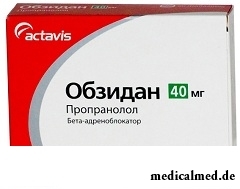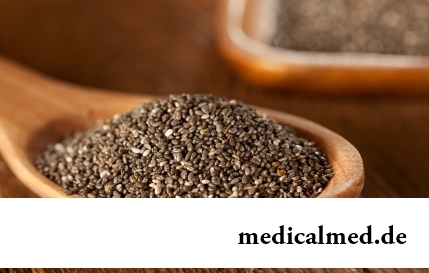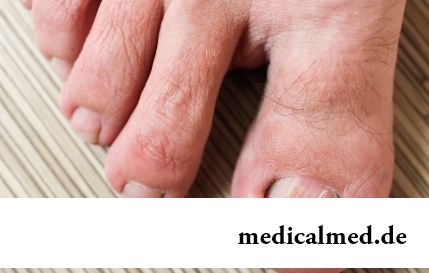





Obsidanum
Application instruction:
 Obsidanum – beta1-and beta2-adrenoblocker, the medicine having anti-hypertensive, anti-anginal and antiarrhytmic effect.
Obsidanum – beta1-and beta2-adrenoblocker, the medicine having anti-hypertensive, anti-anginal and antiarrhytmic effect.
Form of release and structure
Dosage form – tablets: white color, a round form, with slanted edges, on one of the parties – risk, dividing the squeezed-out figures "4" and "0", on the other hand – a smooth surface (on 20 pieces in blisters, on 3 blisters in a pack cardboard).
Active agent: propranolol the hydrochloride, its contents in 1 tablet makes 40 mg.
Auxiliary components: potato starch, magnesium stearate, gelatin, silicon dioxide colloid, sodium carboxymethylstarch (type A), talc, lactoses monohydrate.
Indications to use
- Ciliary tachyarrhythmia;
- Supraventricular tachycardia;
- Angina of exertion;
- Essential tremor;
- Arterial hypertension;
- Supraventricular and ventricular premature ventricular contraction;
- Sinus tachycardia (including at a hyperthyroidism);
- Unstable stenocardia (except for Printsmetal's stenocardia);
- Sympathoadrenal crises against the background of a diencephalic syndrome;
- Thyrotoxicosis and thyrocardiac crisis (Obsidanum is applied as symptomatic drug in case of intolerance of thyreostatic medicines);
- Prevention of attacks of migraine;
- Prevention of a myocardial infarction (systolic arterial pressure is higher than 100 mm hg).
Contraindications
Absolute:
- Chronic obstructive pulmonary disease (in the anamnesis including);
- Tendency to bronkhospastichesky reactions;
- Bronchial asthma;
- Vasculomotor rhinitis;
- Diabetes mellitus;
- Spastic colitis;
- Pheochromocytoma (without co-administration of alpha adrenoblockers);
- Metabolic acidosis (including diabetic ketoacidosis);
- The occlusal diseases of peripheral vessels (complicated by pain at rest or the alternating lameness, gangrene);
- Cardiomegaly if it is not followed by symptoms of heart failure;
- Fluid lungs;
- Sick sinus syndrome;
- Acute heart failure;
- Uncontrollable chronic heart failure of IIB-III of a stage;
- Sinus bradycardia;
- Printsmetal's stenocardia;
- Acute myocardial infarction (systolic arterial pressure is less than 100 mm hg);
- Sinuatrial blockade;
- Atrioventricular block of II and III degrees;
- Arterial hypotension (systolic arterial pressure is lower than 90 mm hg);
- Cardiogenic shock;
- Simultaneous use of antipsychotic means, anxiolytics or monoamine oxidase inhibitors;
- Lactation;
- Hypersensitivity to drug components.
Relative:
- Age up to 18 years;
- Advanced age;
- Pregnancy period;
- Allergic reactions in the anamnesis;
- Reynaud's syndrome;
- Atrioventricular block of the I degree;
- Chronic heart failure of I-IIA of a stage;
- Psoriasis;
- Myasthenia;
- Renal and/or liver failure;
- Pheochromocytoma;
- Hyperthyroidism.
Route of administration and dosage
It is necessary to accept Obsidanum inside, to food: to swallow of tablets entirely and to wash down with enough liquid.
The recommended dosing modes:
- Hyperthyroidism (symptomatic treatment): on 40 mg 3-4 times a day;
- Arterial hypertension: on 40 mg 2 times a day. In case of insufficiency of hypotensive effect the daily dose is raised to 120 mg (on 40 mg 3 times a day) or to 160 mg (on 80 mg 2 times a day). The highest admissible daily dose – 320 mg;
- Disturbances of a cordial rhythm, stenocardia: in an initiation of treatment – on 20 mg 3 times a day (a daily dose – 60 mg), further gradually increase a daily dose to 80-120 mg in 2-3 receptions. The highest daily dose should not exceed 240 mg;
- Treatment of an essential tremor and prevention of migraine: on 40 mg 3 times a day, if necessary further adjust a dose;
- Prevention of a repeated myocardial infarction: treatment is begun between 5 and 21 day after an attack, the first 2-3 days appoint 40 mg 3 times a day (a daily dose – 120 mg), then – on 80 mg 2 times a day (a daily dose – 160 mg). If there is a need, the daily dose is raised to 180-240 mg in 2-3 receptions.
To patients with renal failures increase an interval between receptions or reduce a dose.
At abnormal liver functions reduce a drug dose.
Side effects
- From respiratory system: asthma, laryngospasm, bronchospasm, nose congestion, rhinitis;
- From cardiovascular system: arrhythmias, stethalgia, cold snap of extremities, heartbeat, lowering of arterial pressure, atrioventricular block, sinus bradycardia, orthostatic hypotension, spasm of peripheral arteries, disturbance of conductivity of a myocardium, heart failure;
- From the central and peripheral nervous system: seldom – an asthenic syndrome, excitement, a headache, decline in the ability to bystry mental and motor reactions, drowsiness, dreadful dreams, increased fatigue, hallucinations, dizziness, paresthesias, sleeplessness, short-term loss of memory or confusion of consciousness, weakness, a tremor, a depression;
- From a reproductive system: decrease in a potentiality;
- From the alimentary system: pains in epigastric area, taste change, dryness in a mouth, nausea, lock/diarrhea, vomiting, an abnormal liver function;
- From endocrine system: depression of function of a thyroid gland;
- From sense bodys: visual acuity disturbance, dryness of a mucous membrane of eyes (owing to reduction of secretion of the lacrimal liquid), a keratoconjunctivitis;
- Allergic and dermatological reactions: skin rash, itch, sweating strengthening, aggravation of a course of psoriasis, dieback, alopecia, psoriazopodobny skin reactions, dermahemia;
- From a metabolism: at patients with a diabetes mellitus of type 1 – a hypoglycemia, at patients with a diabetes mellitus of type 2 – a hyperglycemia;
- Others: withdrawal, thorax, spin or joints pain, muscular weakness;
- From laboratory indicators: increase in activity of hepatic transaminases and level of bilirubin, decrease in quantity of leukocytes, granulocytes or thrombocytes in blood.
Special instructions
During treatment it is regularly necessary to control the heart rate and arterial pressure (at the beginning of administration of drug – daily, further – 1 time in 3-4 months), and also the electrocardiogram. Elderly people, besides, need monitoring of a condition of function of kidneys (each 4-5 months).
If at the patient of advanced age renal failures and/or a liver are noted, the amplifying bradycardia (it is less than 50 beats per minute), arterial hypotension (systolic arterial pressure less than 100 mm hg), an atrioventricular block, ventricular arrhythmias, a bronchospasm, it is necessary to lower a dose of Obsidanum or to cancel it at all.
The doctor has to train each patient in a technique of calculation of heart rate and inform on need to address for consultation if this indicator makes less than 50 beats per minute.
It is recommended to stop treatment in case of development of the depression caused by the carried-out therapy.
Propranolol can reduce products of the lacrimal liquid that should be considered to people who carry contact lenses.
To patients with heart failure (at early stages) Obsidanum can be appointed only after a therapy course diuretics and/or cardiac glycosides.
Treatment of persistent arterial hypertension and coronary heart disease has to be long, up to several years.
Drug withdrawal should be made gradually, reducing a dose under control of the doctor as in case of the sharp termination of treatment deterioration in tolerance to an exercise stress, strengthening of ischemia of a myocardium and a pain syndrome is possible at stenocardia. The optimum period of cancellation of Obsidanum – not less than 2 weeks with a dose decline for 25% each 3-4 days.
Under control of content of glucose in blood (each 4-5 months) treatment there have to undergo patients with a diabetes mellitus. Extra care should be observed to people who receive hypoglycemic means as during long breaks in meal there is a risk of development of a hypoglycemia. At the same time its expressed signs, such as tremor and tachycardia, will mask effect of propranolol. The doctor has to inform patients that the main symptom of a hypoglycemia during use of this drug is the increased sweating.
In a combination with insulin Obsidanum can lead to a hypoglycemia, with peroral hypoglycemic drugs – to a hyperglycemia.
At a thyrotoxicosis propranolol can mask the main symptoms of a disease (for example, tachycardia). In case of sharp drug withdrawal strengthening of symptomatology is possible.
At a pheochromocytoma Obsidanum can be appointed only in a combination with alpha adrenoblockers.
Patients who along with propranolol receive a clonidine can carry out its cancellation only in several days after cancellation of Obsidanum.
The patients receiving Obsidanum in combination with the drugs reducing stocks of catecholamines (for example, Reserpinum), during treatment have to be under constant medical control as strengthening of effect of propranolol is possible that is shown by bradycardia and arterial hypotension.
In need of performing surgery under the general anesthesia using ether or chloroform for several days it is necessary to stop reception of Obsidanum since the risk of development of arterial hypotension and oppression of function of a myocardium increases.
It is also necessary to cancel drug before carrying out researches on the content in urine and blood of vinilamidalny acid, catecholamines and a normetanefrin, and also credits of antinuclear antibodies.
Efficiency of propranolol decreases at patients who abuse smoking.
During therapy it is necessary to refrain from the use of a natural liquorice and alcohol, and also from driving of the car and performance of any kinds of the works requiring special attention and high speed of psychophysical reactions.
It is necessary to consider that food rich with protein can increase bioavailability of propranolol.
Medicinal interaction
- Monoamine oxidase inhibitors: considerably anti-hypertensive effect of propranolol amplifies (use of such combination is contraindicated; the interval between administrations of drugs should not be less than 14 days);
- Amiodaronum, verapamil, diltiazem: expressiveness negative dromo-, other and chronotropic action amplifies (such combinations are not recommended);
- Derivatives of a fenotiazin: mutual increase in concentration of both drugs is observed;
- Ethanol, hypnotic drugs and sedative drugs, neuroleptics, three - and tetracyclic antidepressants: expressiveness of the oppressing effect of propranolol on the central nervous system amplifies;
- Cimetidinum: bioavailability of propranolol increases;
- Ethanol, diuretics, гидралазин, Reserpinum and other hypotensive drugs: anti-hypertensive effect of propranolol amplifies;
- Glucocorticosteroids, non-steroidal anti-inflammatory drugs, estrogen: the hypotensive effect of Obsidanum is weakened;
- Uterotoniziruyushchy drugs, tireostatik: their action amplifies;
- Antihistaminic drugs: their action decreases;
- Rifampicin: the propranolol elimination half-life decreases;
- Antiarrhytmic drugs, cardiac glycosides, гуанфацин, Reserpinum, Methyldopum: the risk of development or aggravation of bradycardia, development of an atrioventricular block and heart failure, a cardiac standstill increases;
- Theophylline, xanthines (except for Diphyllinum): their clearance decreases;
- Coumarins: their anticoagulating effect is prolonged;
- Insulin and peroral hypoglycemic means: their effect changes, symptoms of the developing hypoglycemia are not shown;
- Lidocaine: concentration of propranolol in a blood plasma increases;
- Phenytoinum entered intravenously, the means of an inhalation anesthesia which are derivatives of hydrocarbons: expressiveness of cardiodepressive effect of propranolol and probability of a lowering of arterial pressure increases;
- Sulfasalazinum: propranolol metabolism is slowed down owing to what its concentration in a blood plasma increases;
- Nifedipine: arterial pressure can decrease considerably;
- Not depolarizing muscle relaxants: their action is extended;
- The allergens applied to an immunotherapy or skin tests: the risk of development of heavy system reactions (anaphylaxis) increases;
- Not hydrogenated ergot alkaloids: the probability of development of disturbances of peripheric circulation increases;
- Iodinated X-ray contrast agents intravenously: the risk of development of anaphylactic reactions increases.
Terms and storage conditions
To store in the unavailable to children, protected from light place at a temperature of 15-25 ºС.
Period of validity – 5 years.
Except people, only one living being on the planet Earth – dogs suffers from prostatitis. Here really our most loyal friends.

Life of the modern woman is very difficult. Opportunities to realize itself are wide: it not only education and career, but also most differently...
Section: Articles about health
It would seem, to buy drugs in Moscow does not make a problem – a drugstore, and not one, is available for each resident of the capital within walking distance. And, nevertheless, Internet drugstores become more popular – what it is possible to explain such phenomenon with? Actually m reasons...
Section: Articles about health
For anybody not a secret that the modern person eats not as his ancestors. For the last 100 years in broad access there were absolutely new products which are result of use of the latest technologies in food production. Significantly ways of storage and transportation of food ingredients changed, and people of the whole world had an opportunity to regularly use those products about which their grandfathers and grandmothers did not even know....
Section: Articles about health
Almost each of us during life faced dissatisfaction with own body. At such moments, as a rule, we beginning...
Section: Articles about health
The chia plant, or the Spanish sage, is from South America. The indigenous people of the continent since ancient times used its seeds in food: small, but very nutritious kernels, in a form the reminding fasolina. Indians knew about useful properties of seeds of a chia, and applied...
Section: Articles about health
What is in our understanding weeds? It plants which are considered to be suitable only for compost pits and feeding of animals. Meanwhile, among the weeds growing literally under legs it is possible to find the mass of the officinal herbs having invaluable advantage for human health. It is possible not only to be treated by most of them, using as broths, tinctures, compresses, but also to accept in food as usual products. Let's consider 8 widespread and often ignored by people...
Section: Articles about health
Ability of an organism to resist to adverse environmental factors (to impact of temperature drops, humidity and pressure...
Section: Articles about health
We present to yours the TOP of the medicamentous means exerting the stimulating impact on a potentiality, i.e. on ability of the man to commission of sexual intercourse. At once it is necessary to tell that not always disturbances of erectile function can be eliminated with reception of t...
Section: Articles about health
The word "onikhokriptoz" is unfamiliar to most of people, meanwhile quite so physicians call very widespread problem: the growing of edge of a nail into surrounding fabrics causing inflammatory process. Usually the illness affects thumbs of legs, and is followed by reddening, hypostasis, and in the started cases – release of pus. Patients complain of the pain amplifying when walking, problems with the choice of footwear....
Section: Articles about health
During foot walks blood moves on vessels more actively and one and all bodies are supplied with a large amount of oxygen. N...
Section: Slideshow
History of use of an anesthesia during operations contains more than 160 years. Annually in the world hundreds of thousands of surgical interventions during which to patients the substances immersing them in a dream and saving from pain are entered are carried out. Using an anesthesia to these...
Section: Articles about health
You are office worker, the driver, the fan of winter sports or do not think of life without bicycle? You lead a slow-moving life and you move on the city only on the car? You have no constant partner and you do not love the protected sex? Attention! You unambiguously are a potential target for prostatitis. It is not necessary to panic, it is necessary to work....
Section: Articles about health
The endocrine system carries out in a human body extremely important role, practically all processes of life activity регулируютс...
Section: Articles about health
Each failure in work of bodies and systems of a human body is, as a rule, shown by the whole complex of symptoms. In particular, malfunctions with health often cause emergence of cosmetic defects in the form of rashes on a face. Experienced doctors know that локализац...
Section: Articles about health
The majority of gynecologic diseases prove three main signs, each of which speaks about need of a visit to the gynecologist. Certainly, it is possible to establish the exact diagnosis only after inspection, but on the basis of some signs it is possible to assume existence of this or that pathology. Let's consider symptoms of the female diseases which are found most often....
Section: Articles about health
Helminthosis is one of the most widespread diseases. Statistically, with any species of helminths it is infected porridges...
Section: Articles about health
Cold is such painful that each sigh becomes a victory, heat "knocks" down, and the ache in joints forces to think only of pain. Some people with approach of the first symptoms of cold make the self-sacrificing decision to have a disease standing, and to a beam...
Section: Articles about health
Eyes – unique body on the structure thanks to which the person obtains about 80% of information on the world around: about a form, color, size, the movement, and also many other parameters of objects or phenomena. But whether much we know about the most valuable sense body which, according to the scientist Sechenov, provides us about one thousand various feelings a minute? Let's consider 10 most surprising facts about eyes and sight....
Section: Articles about health
The winter swimming in open reservoirs called in our country by "winter swimming" – officially recognized sport and one of the ek...
Section: Articles about health
The popular expression "run from a heart attack" became the motto of the people supporting active lifestyle. Moreover, run became a peculiar fashionable tendency: sales of racetracks and the accompanying goods for run are at permanently high level. Really...
Section: Articles about health
Hemorrhoids – extremely widespread disease. Periodically arising inflammations and bleeding of hemorrhoidal nodes cause serious discomfort to nearly fifteen percent of adults. Meanwhile, having a clear idea of the reasons of an exacerbation of an illness and following rules of precaution, it is possible to reduce substantially sharpness of unpleasant feelings and to reduce progressing of a disease....
Section: Articles about health
Partial and the more so full loss of hearing significantly reduces quality of life. Difficulties with communication lead to loneliness and замкн...
Section: Articles about health
One of the major chemical processes happening in a human body are oxidation reactions. They go with participation of fats and carbohydrates which we receive from food, and the oxygen getting to us from air. A main goal of such reactions is it is received...
Section: Articles about health
Contrary to popular belief, the multiple sclerosis (MS) is not connected neither with sclerous changes of walls of vessels, nor with age forgetfulness and problems with concentration of attention. This disease has the autoimmune nature. Pathological process is expressed in degradation of nervous tissue and destruction of its enveloping layer - a myelin. Multiple damages of the central nervous system which are shown by decrease in sight, bystry fatigue, on become result of development of an illness...
Section: Articles about health
Each person supports all life a SARS about 200 times. The peak of incidence falls on cold season, but to get sick from temperatures...
Section: Articles about health
The stroke is one of the most widespread diseases of the person, annually in the world about 6 million cases of this pathology are registered. According to medical statistics, strokes occur almost three times more often than myocardial infarctions. Disease otno...
Section: Articles about health
Tuberculosis – a serious infectious disease which development is caused by mycobacteria (Koch's bacilli). The illness is known from an extreme antiquity. Long time fight against it was considered as ineffective. Quite often the disease affected the whole families, and mortality from it was very high. It became the reason of emergence of a set of delusions concerning transmissibility and a possibility of treatment of tuberculosis....
Section: Articles about health
